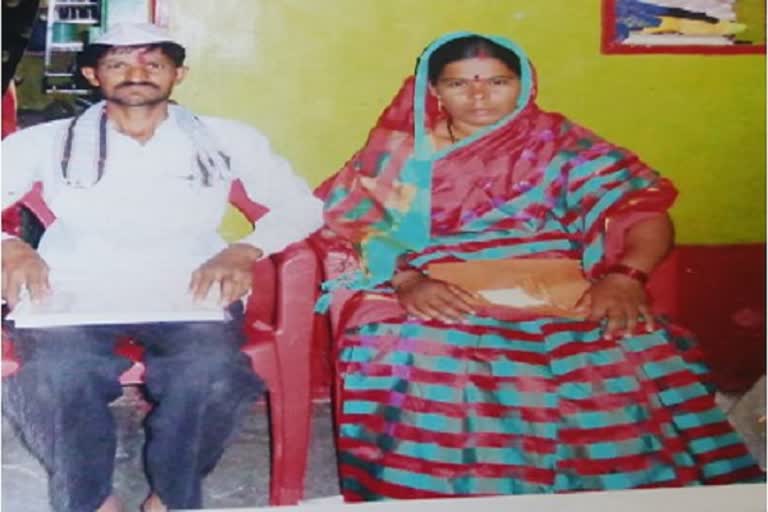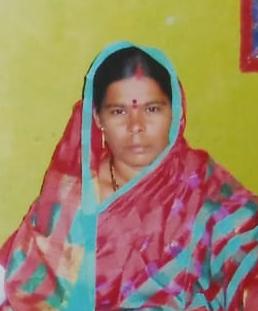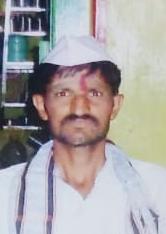ETV Bharat / bharat
భార్యను చంపి.. మూడు రోజులు ఇంట్లోనే దాచిపెట్టి.. - Husband kills his wife for second marriage in karnataka
ఓ వ్యక్తి తన భార్యను చంపి మూడు రోజుల పాటు సొంత ఇంట్లోనే దాచిపెట్టిన దారుణ ఘటన కర్ణాటక కలబుర్గి జిల్లాలోని హిప్పరాగ గ్రామంలో చోటుచేసుకుంది. సంతానం లేకపోవడం, మరో వివాహానికి భార్య అంగీకరించకపోవడం వల్లే నిందితుడు ఈ హత్య చేసినట్లు భావిస్తున్నారు. పరారీలో ఉన్న నిందితుడి కోసం పోలీసులు గాలిస్తున్నారు.

భార్యను చంపి మూడు రోజులు ఇంట్లోనే దాచిపెట్టాడు
By
Published : Nov 5, 2019, 5:30 PM IST
కర్ణాటక కలబుర్గి జిల్లా అలంద తాలూకాలోని హిప్పరాగ గ్రామంలో ఘోరం జరిగింది. పిల్లలు పుట్టడంలేదనే కారణంతో ఓ వ్యక్తి తన భార్యను హత్యచేసి.. మూడు రోజులపాటు తన ఇంట్లోనే దాచిపెట్టాడు.
సంతానం కలగలేదని!
హిప్పరాగకు చెందిన 45ఏళ్ల శ్రీశైలక్ సక్కరాగి డ్రైవర్గా పనిచేసేవాడు. సంగీతను కొన్ని సంవత్సరాల క్రితం పెళ్లి చేసుకున్నాడు. ఆ తర్వాత వారికి ఓ ఆడబిడ్డ పుట్టి చనిపోయింది. ఆ తరువాత ఆమెకు సంతానం కలుగలేదు. ఇదే విషయమై భార్యను ఎప్పుడూ వేధిస్తుండేవాడు శ్రీశైలక్. మరో పెళ్లి చేసుకోవడానికి సిద్ధపడ్డాడు. దీనితో భార్యాభర్తల మధ్య మూడు రోజుల క్రితం గొడవ జరిగింది.
సంతానం కలగడం లేదనే కోపం, మరో వివాహం చేసుకోవడానికి భార్య అంగీకరించకపోవడం వల్ల శ్రీశైలక్ తన భార్యను గొంతు నులిమి చంపేశాడు. ఈ విషయం ఎవరికీ తెలియకుండా ఆమె శవాన్ని మూడు రోజులపాటు తన ఇంట్లోనే దాచిపెట్టాడు. ఈ దురాగతం బయటకు పొక్కడం వల్ల అక్కడి నుంచి పరారయ్యాడు.
శ్రీశైలక్, అతని తల్లి పార్వతిలపై పోలీసులు కేసు నమోదుచేశారు. పరారీలో ఉన్న నిందితుని కోసం తీవ్రంగా గాలిస్తున్నారు.
ఇదీ చూడండి: ఆదర్శం: అప్పు ఇవ్వలేదని బ్యాంకే పెట్టేసింది
కర్ణాటక కలబుర్గి జిల్లా అలంద తాలూకాలోని హిప్పరాగ గ్రామంలో ఘోరం జరిగింది. పిల్లలు పుట్టడంలేదనే కారణంతో ఓ వ్యక్తి తన భార్యను హత్యచేసి.. మూడు రోజులపాటు తన ఇంట్లోనే దాచిపెట్టాడు.
సంతానం కలగలేదని!
హిప్పరాగకు చెందిన 45ఏళ్ల శ్రీశైలక్ సక్కరాగి డ్రైవర్గా పనిచేసేవాడు. సంగీతను కొన్ని సంవత్సరాల క్రితం పెళ్లి చేసుకున్నాడు. ఆ తర్వాత వారికి ఓ ఆడబిడ్డ పుట్టి చనిపోయింది. ఆ తరువాత ఆమెకు సంతానం కలుగలేదు. ఇదే విషయమై భార్యను ఎప్పుడూ వేధిస్తుండేవాడు శ్రీశైలక్. మరో పెళ్లి చేసుకోవడానికి సిద్ధపడ్డాడు. దీనితో భార్యాభర్తల మధ్య మూడు రోజుల క్రితం గొడవ జరిగింది.
సంతానం కలగడం లేదనే కోపం, మరో వివాహం చేసుకోవడానికి భార్య అంగీకరించకపోవడం వల్ల శ్రీశైలక్ తన భార్యను గొంతు నులిమి చంపేశాడు. ఈ విషయం ఎవరికీ తెలియకుండా ఆమె శవాన్ని మూడు రోజులపాటు తన ఇంట్లోనే దాచిపెట్టాడు. ఈ దురాగతం బయటకు పొక్కడం వల్ల అక్కడి నుంచి పరారయ్యాడు.
శ్రీశైలక్, అతని తల్లి పార్వతిలపై పోలీసులు కేసు నమోదుచేశారు. పరారీలో ఉన్న నిందితుని కోసం తీవ్రంగా గాలిస్తున్నారు.
ఇదీ చూడండి: ఆదర్శం: అప్పు ఇవ్వలేదని బ్యాంకే పెట్టేసింది
RESTRICTION SUMMARY: AP Clients Only, Part Must Credit Norfolk Ponds Project, Part Must Credit University College London, Part Must Credit North Dakota Game and Fish Department
SHOTLIST:
++CLIENTS PLEASE NOTE: This is the eighth episode in a 12-part multimedia series that highlights intense efforts being waged around the world to save or revive ecosystems, reversing some of humankind's most destructive past actions and preserving vital natural habitats on earth. The Associated Press series asks: What Can Be Saved?
This week's story looks at how efforts are being made around the world to reclaim wetlands that have been filled in to plant crops or fill other human needs.++
ASSOCIATED PRESS - AP CLIENTS ONLY
Hindolveston, England - 13 September 2019
1. Various chain saw to clear trees and shrubs covering pond
2. Wide of tree falling after being sawed. UPSOUND Crackling of breaking tree
3. Various aerial shots of team members working, "restoring" pond ++MUTE++
4. SOUNDBITE (English) Carl Sayer, Associate Professor, University College London:
"When we restore ponds, we bring water back into the landscape. So our restored ponds at the moment are almost the only ponds with any water in - this is dry. So when we restore it, it will have water."
5. Various of digger excavating pond
6. SOUNDBITE (English) Carl Sayer, Associate Professor, University College London:
"It's a no brainer for conservation, and not just in Norfolk, everywhere."
7. Sayer working with team members and clearing branches
8. SOUNDBITE (English) Carl Sayer, Associate Professor, University College London:
"The last 10 years, we've been doing before and after surveys, and we've watched populations of dragonflies, of amphibians, explode. We've seen farmland birds be drawn into these places."
HANDOUT - MUST CREDIT NORFOLK PONDS PROJECT
Norfolk, England - Date not given
9. Wide of deer approaching restored pond
ASSOCIATED PRESS - AP CLIENTS ONLY
Hindolveston, England - 13 September 2019
10. SOUNDBITE (English) Carl Sayer, Associate Professor, University College London:
"We've seen animals coming in to drink when they are thirsty. This is a drought summer."
HANDOUT - MUST CREDIT NORFOLK PONDS PROJECT
Norfolk, England - Date not given
11. Red deer drinking in the middle of the pond
ASSOCIATED PRESS - AP CLIENTS ONLY
Hindolveston, England - 13 September 2019
12. Close of flower, bees
13. Close of dragonfly
ASSOCIATED PRESS - AP CLIENTS ONLY
Hindolveston, England - 13 September 2019
14. SOUNDBITE (English) Andy Hind, Volunteer and Environmental Scientist:
"We find with these restored ponds, within a year or two, they come back and they do extremely well."
15. Close of frog in Hind's hand
16. Wide of Hind releasing frog UPSOUND (English): "Off you go little fellow, you go and find somewhere nice."
HANDOUT - MUST CREDIT UNIVERSITY COLLEGE LONDON (UCL)
Norfolk, England - Date not given
17. Underwater shot of "restored" farmland pond
ASSOCIATED PRESS - AP CLIENTS ONLY
Hindolveston, England - 13 September 2019
18. SOUNDBITE (English) Helen Greaves, PhD Student, UCL Pond Restoration Research Group:
"And what's wonderful is you've got this underwater life going on, a whole community is happening under the water, and you have no idea about it."
19. Various Greaves taking sample from previously "restored" pond
20. SOUNDBITE (English) Helen Greaves, PhD Student, UCL Pond Restoration Research Group:
"And if we see lots of different things living, it means there's lots of different habitats for them to live in, lots of different homes. And that means that we have created and restored a very good, healthy pond."
21. Pan right of previously "restored" pond
ASSOCIATED PRESS - AP CLIENTS ONLY
LaMoure County, North Dakota - 20 June 2019
22. Various aerial shots of prairie potholes
ASSOCIATED PRESS - AP CLIENTS ONLY
Coleharbor, North Dakota - 18 June 2019
23. SOUNDBITE (English) Todd Frerichs, US Fish & Wildlife Service:
"A prairie pothole is a natural wetland that was created by glaciers, as the glaciers moved their way south out of Canada into the Dakotas."
ASSOCIATED PRESS - AP CLIENTS ONLY
LaMoure County, North Dakota - 20 June 2019
24. Various aerial still photos of prairie potholes
ASSOCIATED PRESS - AP CLIENTS ONLY
Coleharbor, North Dakota - 18 June 2019
25. Mid of Frerichs looking through binoculars
26. Wide pan right of prairie pothole
27. Close of water and grass
28. SOUNDBITE (English) Todd Frerichs, US Fish & Wildlife Service:
"As we reduce wetlands in the landscape, that reduces not only just wildlife habitat for waterfowl and other migratory birds, but it also reduces groundwater aquifer recharge. It increases potential for flooding, and it also affects sequestration of carbon."
ASSOCIATED PRESS - AP CLIENTS ONLY
Menoken, North Dakota - 20 June 2019
29. Mid of ducks swimming
HANDOUT - CREDIT NORTH DAKOTA GAME AND FISH DEPARTMENT
Location - Date unknown
30. Various of migrating birds
ASSOCIATED PRESS - AP CLIENTS ONLY
Bismarck, North Dakota - 21 June 2019
31. SOUNDBITE (English) Daryl Lies, North Dakota Farm Bureau:
"There's so many government regulations and so many in the environmental world and in the wildlife world that want to tell us what to do on our property."
32. Various of Lies looking out over property
33. SOUNDBITE (English) Daryl Lies, North Dakota Farm Bureau:
"Farmers and ranchers don't want to destroy wetlands. But having an ability to mitigate them, very reasonable priced and easily, would help."
ASSOCIATED PRESS - AP CLIENTS ONLY
Menoken, North Dakota - 20 June 2019
34. Mid of small bird sitting on a post and singing
35. Various of ducks on the water
ASSOCIATED PRESS - AP CLIENTS ONLY
McClusky, North Dakota - 19 June 2019
36. Mid of prairie potholes
ASSOCIATED PRESS - AP CLIENTS ONLY
McKenzie, North Dakota - 21 June 2019
37. Mid of Jerry Doan driving ranch vehicle
38. SOUNDBITE (English) Jerry Doan, rancher:
"We all love wildlife, if you like to hunt or not, or if you just like them, and it's good for our ecosystem, it's good for - again - preserving our natural resources."
39. Mid of Doan walking past the camera with prairie grass in foreground
ASSOCIATED PRESS - AP CLIENTS ONLY
McClusky, North Dakota - 19 June 2019
40. Wide of wetland
ASSOCIATED PRESS - AP CLIENTS ONLY
McKenzie, North Dakota - 21 June 2019
41. SOUNDBITE (English) Jerry Doan, rancher:
"You know a balance of protecting wildlife, having habitat, and then finding ways for us to be profitable in agriculture - that's all important."
ASSOCIATED PRESS - AP CLIENTS ONLY
Menoken, North Dakota - 20 June 2019
42. Various scenes of wildlife around a prairie pothole
ASSOCIATED PRESS - AP CLIENTS ONLY
Hindolveston, England - 13 September 2019
43. Close of leaves and branches silhouetted at sunset
44. Tilt down to "restored" pond in farmer's filed
45. Mid tilt down on pond
46. Pull focus of pond surface
STORYLINE:
Around the world, efforts are being made to reclaim wetlands that have been filled in to plant crops.
A team of researchers, farmers and conservationists recently dug into barley and wheat fields in eastern England in search of lost ponds lurking beneath. Using chain saws and an excavator, it took just a few hours to resurrect a dying pond near Hindolveston, a thousand-year-old village not far from the North Sea.
"When we restore ponds, we bring water back into the landscape," says Carl Sayer of University College London.
Almost 90 percent of the world's wetlands disappeared over the past three centuries, with the losses rapidly accelerating since the 1970s. Their disappearance can trigger environmental woes including rising floods and species threatened with extinction. Climate change also threatens to worsen the problem.
After ghost ponds are dug out, seeds from long-buried water plants come to life. So do the insects that depend on them, followed by fish and birds that eat the insects.
"And if we see lots of different things living, it means there's lots of different habitats for them to live in, lots of different homes. And that means that we have created and restored a very good, healthy pond," says Helen Greaves, a researcher at University College London.
In North America, several million prairie potholes – natural wetlands created by glaciers -- are spread across a region that covers portions of five U.S. states and three Canadian provinces. One by one, they're being drained or plowed under to make way for crops.
Hundreds of millions of dollars have been spent trying to reverse or at least halt the losses including payments to ranchers. But some government biologists and wetlands advocates say such projects don't fully restore what's lost.
Each spring and fall bring an even greater influx of waterfowl: clouds of migrating snow geese that descend en masse, lingering for a few days on the larger water bodies as they pass between breeding grounds in Canada and their winter refuges to the south.
But to farmers, these wetlands carved into the earth by glaciers some 10,000 years ago can be an adversary. The muddy holes bog down tractors and rot newly planted seeds and they can kill young crops, leaving patches of lifeless stalks.
"Farmers and ranchers don't want to destroy wetlands," says Daryl Lies of the North Dakota Farm Bureau. "But having an ability to mitigate them, very reasonable priced and easily, would help."
Rancher Jerry Doan, who has restored some wetlands on his property, believes there's a middle ground.
It's "a balance of protecting wildlife, having habitat, and then finding ways for us to be profitable in agriculture -- that's all important," says Doan.
## WHAT CAN BE SAVED
This Associated Press series was produced in partnership with the Howard Hughes Medical Institute's Department of Science Education. The AP is solely responsible for all content.
===========================================================
Clients are reminded:
(i) to check the terms of their licence agreements for use of content outside news programming and that further advice and assistance can be obtained from the AP Archive on: Tel +44 (0) 20 7482 7482 Email: info@aparchive.com
(ii) they should check with the applicable collecting society in their Territory regarding the clearance of any sound recording or performance included within the AP Television News service
(iii) they have editorial responsibility for the use of all and any content included within the AP Television News service and for libel, privacy, compliance and third party rights applicable to their Territory.





